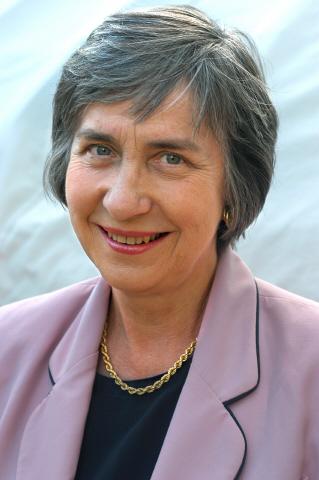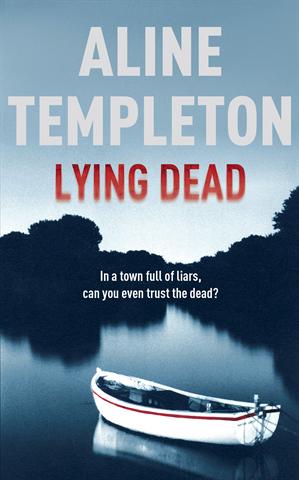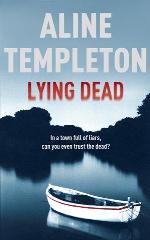|
Aline Templeton lives in Edinburgh, Scotland with her husband
and their Dalmatian dog, in a house with a balcony built by an
astronomer to
observe the stars over the beautiful city skyline. She has worked in
education
and broadcasting and has written numerous articles and stories for
newspapers
and magazines. Although LYING DEAD is the third in the DI Marjory
Fleming
series she has written seven others dating back to 1984.
If you're not a writer yourself, you'll
have no idea how terrifying it is to face a blank sheet of paper, or a
blank
screen, and try to think how to start a book.
So I cheat. When
I think I have a
good, sound idea I live with it for months, sometimes years, before I
think of
starting, and when I do actually sit down at my desk I have at least
the whole
of the first paragraph word for word worked out in my head.
My early books were stand-alone novels, so
you really do start from nothing – but then, you also have
total freedom. It
was a big decision to start a series, as I
did three years ago. Once I'd deliberately tied myself down to a
specific area,
and a specific central character, how would I come up with really fresh
ideas? Would I,
like Agatha Christie with Hercule
Poirot, end up hating my main character, and, if I was successful, have
to go
on writing about the bastard and only be allowed to kill him off once I
was
dead myself? Did I really want to risk it?
But one day, DI Marjory Fleming came into
my mind very clearly. She
was a tall,
athletic-looking Scotswoman – Big Marge to her subordinates
– tough, humorous
and sharp-tongued. Before
I knew what
else she was, I knew what she wasn't: she wasn't a dysfunctional loner,
with a
string of failed relationships and an alcohol problem.
She was the sort of woman you'd find down the
local nick, a working mother with a farmer husband, Bill, teenage kids
and
aging parents giving her the problems all modern women are faced with
while
tackling the difficult, demanding and fascinating job of a senior
police
officer.
Her sidekick sprang into life too: DS Tam
MacNee, a wee Glasgow hard man with a dubious past, a predilection
for quoting Robert
Burns, and a self-imposed uniform of trainers, jeans, a white T-shirt
and a
black leather jacket whatever the weather.
It was only recently I remembered that I had met a
detective so clad,
many years ago, a splendid chap who was talking to me about the work of
police
dogs in dealing with vandalism. I
asked
him what they did when they found the culprits – cornered
them, snarling,
perhaps? He
looked at me pityingly and
said, 'They bite them.' I never saw him again, but
he lives on in Tam
MacNee.
With a stand-alone novel, nothing more
happens to the characters when the book is finished.
You open the box, set them all out, then put
them back and shut it again. But give them a series, and it's all
different.
They have an existence even when you're not writing about them. It's a
bit
strange to start with – the sense that they're just going on
having an ordinary
daily life and in the next book you have to catch up with what has been
happening to them when you weren't there.
You need to accept, too, that you can't change their
personalities to
suit the plot. They're people, not just collections of useful
attributes. With
every book more emerges about their past life, their present
relationships,
their moral principles and their likes and dislikes.
It's like getting to know a new friend, and
they are still surprising me.
My greatest fear, that I'd be scratching
around for ideas, was happily unjustified. Just the other way round, in
fact –
do you remember how much harder it was in primary school when the
teacher
couldn't be bothered to think of a topic and just said, 'Write a story
about
anything you like?' Having
the place and
the characters established seems a stimulus to creativity and plots
suggest
themselves out of the situations set up in previous books, and out of
the
atmosphere of the place.
It was carefully chosen.
Galloway, in south-west Scotland,
has huge variety. There's
a stunningly
beautiful coastline as well as hills, forests and lochs. It has towns with proper
shops instead of
chain stores, and villages and hamlets and estates and farms. There's still an
old-fashioned sense of community
linking the local people, and whenever I spend time there I discover
some new
aspect of its character. And
it's ideal
for tax-deductible holidays – I mean, of course, research
trips undertaken
wholly and exclusively for business purposes. Honestly, it's pure
coincidence
it wasn't set in Slough.
But rural areas aren't a paradise any more
than inner cities are. The
first book in
the series, Cold in the Earth,
takes
place during the foot-and-mouth epidemic and it struck me then that for
those
of us who live in towns, this was something very much in the past, a
bad memory
and no more. But
the countryside didn't
recover when it wasn't a news story any more, and deep scars linger,
even
today.
It started me thinking about the background
to future books. Glossy
country
magazines promote the countryside as an idyll of meadows full of
rosy-cheeked
children tumbling about, and pretty cottages with gingham curtains and
shelves
of jewel-like preserves and the smell of baking never very far away. It's not like that. I grew up in a picturesque
fishing village
where there's no fishing any more and the wild young men who could have
done
their risk-taking in gales in the North Sea turn to even more deadly pastimes.
My second book, The Darkness and
the Deep, was written about that sort of village.
Lying
Dead, just out
in paperback, is set in a charming
hamlet where local people have been priced out by second-home owners,
and Lamb to the Slaughter (out in
May)
starts with a protest meeting when a thriving market town is threatened
with a
superstore which will strangle local businesses.
I've had direct experience of how deeply
people feel, on both sides of that argument.
In each case, the background has suggested
a plot to me, but then it takes off in ways I never quite expect. When I start a new book, I
usually have an
idea of the beginning and the end, but it's always a great surprise to
read any
synopsis I've written after I've finished the book.
I
attach a warning now that it mustn't be used for publicity
purposes –
this was after I found, to my horror, the synopsis of one of my early
books in
the publisher's catalogue, by which time the weapon used, the victim
and the
names of the characters had all changed.
Everyone has a different way of working, but personally, I
think if I
knew in advance all that was going to happen, I'd get very stale. My motivation for writing
is to see what
happens next. I'm
telling a story to
myself as well as to the reader. It
seems almost embarrassing to say this – I'm not in the least
bit fey, despite
my Highland granny – but I always look forward
to writing a scene with Tam
MacNee because he's funny and caustic and I want to see what he says
this
time. No, I
don’t understand it
either. And OK,
it's weird. But
that's what it's like, for me.
LYING
DEAD is published by Hodder Stoughton
24/1/08 pbk £6.99
DI
Marjory Fleming
Cold
in the Earth (2005)
The
Darkness and the Deep (2006)
Lying
Dead (2007)
Stand Alones:
Death
is My Neighbour (1984)
Last
Act of All (1995)
Past
Praying for (1996)
The
Trumpet Shall Sound (1997)
Night
and Silence (1999)
Shades
of Death (2001)
Lamb
to the Slaughter (2008)
|







